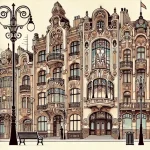Spadina House Museum – A Toronto museum with examples of Art Nouveau and Art Deco
Spadina House, located in Toronto, Ontario, Canada, is a historic house museum that offers visitors a glimpse into the domestic life of an upper-class Canadian family from the early 20th century.
While the house was originally built in the 1860s and underwent various renovations over the decades, much of its current interior design and decorative elements were shaped in the late 19th and early 20th centuries—precisely the period when Art Nouveau and Art Deco were coming into vogue. These styles are reflected in both the architecture and the carefully preserved furnishings of the home.
One of the most notable examples of Art Nouveau within Spadina House is the decorative frieze in the billiards room, created by Gustav Hahn, a German-Canadian artist often credited with introducing Art Nouveau to Canada. Hahn’s work is characterized by its sinuous lines and stylized natural motifs, and the frieze is no exception—featuring flowing, organic forms and pastel tones that evoke a sense of elegance and refined modernism typical of the movement.
In addition to the frieze, the house contains a number of decorative objects, textiles, light fixtures, and furniture that embody the fluid lines, floral patterns, and craftsmanship of the Art Nouveau style. As the decades progressed, newer rooms in the house began to incorporate the geometric patterns, sleek surfaces, and rich materials associated with the Art Deco aesthetic, illustrating the evolution of design through the 1920s and 1930s.
Location: 285 Spadina Road, Toronto, Ontario
